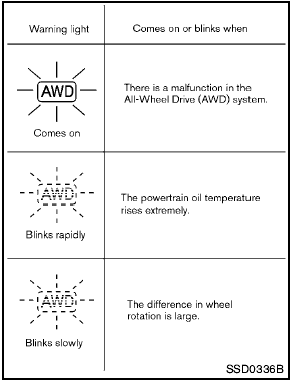AWD warning light

The AWD warning light is located in the meter.
The AWD warning light illuminates when the ignition switch is turned to the ON position. It turns off soon after the engine is started.
If any malfunction occurs in the AWD system while the engine is running, the warning light will come on.
The warning light may blink rapidly (about twice per second) while trying to free a stuck vehicle due to high powertrain oil temperature. The driving mode may change to 2WD. AUTO mode may change to LOCK mode before the warning light blinks. If the warning light blinks rapidly during operation, stop the vehicle with the engine idling in a safe place immediately. Then if the light turns off after a while, you can continue driving.
A large difference between the diameters of front and rear wheels will make the warning light blink slowly (about once per two seconds). Pull off the road in a safe area, and idle the engine.
Check that all tire sizes are the same, tire pressure is correct and tires are not worn.

- If the warning light remains on after the above operation, have your vehicle checked by a NISSAN dealer as soon as possible.
- If the warning light comes on while driving there may be a malfunction in the AWD system. Reduce the vehicle speed and have your vehicle checked by a NISSAN dealer as soon as possible.
- The powertrain may be damaged if you continue driving with the warning light blinking rapidly.
- Never drive on dry hard surface roads in the LOCK mode, as this will overload the powertrain and may cause a serious malfunction.
See also:
Operating tips
To get the best performance out of the NISSAN
Voice Recognition system, observe the following:
- Keep the interior of the vehicle as quiet as
possible. Close the windows to eliminate
surroundi ...
Snow tires
If snow tires are needed, it is necessary to select
tires equivalent in size and load rating to the
original equipment tires. If you do not, it can
adversely affect the safety and handling of yo ...
Oil viscosity
The engine oil viscosity or thickness changes
with temperature. Because of this, it is important
to select the engine oil viscosity based on the
temperatures at which the vehicle will be
opera ...
